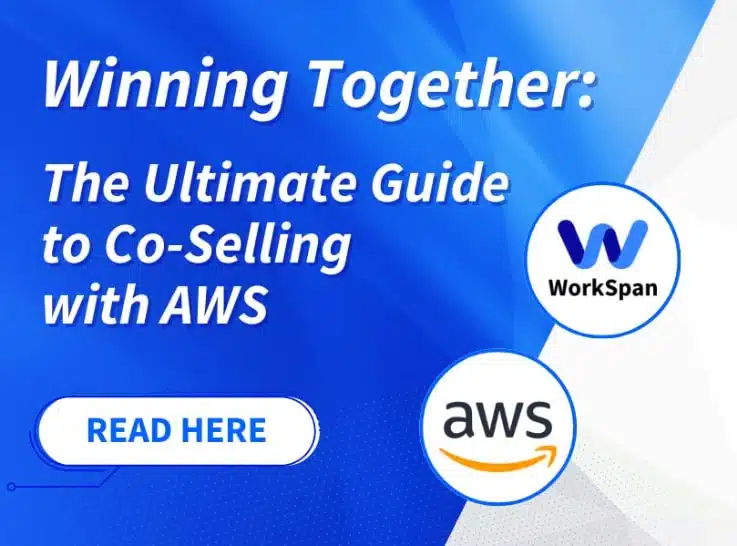
We are approaching a transformational time in technology, and financial markets in general.
Buyers are cutting budgets, increasing sales cycles, and generally thinking twice before purchasing software.
This shift in buyer behavior means that businesses need to change tactics and find new and innovative ways to approach customers and provide value.
One way successful businesses are doing this is by adopting collaborative selling techniques, namely co-selling.
In the world of partnerships, co-selling is:
“The process where two or more peer-level partners with complementary offerings come together to provide a holistic solution to a shared customer need and work collaboratively to sell together”
It’s a powerful way of doing business. Not only are you offering a complete solution to the customer, but also combining the joint selling and marketing engines of two companies. Now let’s take that example a little further. Imagine if you had the opportunity to make use of the selling and marketing resources of a company like AWS? In fact – many companies right now are co-selling with AWS and getting a ton of value from doing so. In this guide, we’ll break down the tips and tricks needed to become an expert in co-selling with AWS and get you in a position to start crushing your revenue goals. So let’s get started….
Why does AWS co-sell with partners?
A bit of background is useful before getting into the heart of this article. Namely, why does Amazon care about co-selling with other companies?
Well just as you have competitors, AWS has competitors in the form of Microsoft Azure and Google Cloud. Presenting a whole solution and working with partners not only delivers better value for AWS customers, but also creates other advocates for AWS to rely on to mitigate potential churn risk.
For example, if AWS has helped Company A land a customer through co-selling with them and adding their clout to a potential deal, they can then leverage that relationship in the future.
If that same mutual customer shows that they are perhaps looking at switching to Azure as their cloud provider, AWS can leverage their relationship with Company A, to help save that customer from potential churn.
The true nature of a great partnership is mutual reciprocity and even a company as large as AWS realizes the benefit in supporting their partner ecosystem and creating advocates that can come to their assistance if needed.
Now that we have a clear picture of the “why”, let’s dive into the process of co-selling with AWS.
Signing up to co-sell with AWS
The best place to start is at the beginning.
Before spending the time to develop an amazing co-selling program, you need to do the basics.
Signing up for the AWS’ ACE Program is step one in getting this entire process started.
There are 2 main steps:
- Sign up for the AWS Partner Program here.
- Next, log in and accept the partner terms and conditions.
Once you have run through these few basic steps, you are now ready to start partnering with AWS and co-selling.
Easy?
Not quite – this is where things get interesting. Even though you’ve signed up for the AWS Partner Program, you aren’t truly ready to begin co-selling with anyone, let alone AWS.
Is your organization ready for co-selling with AWS?
As mentioned above, now is the time to get things set up internally prior to engaging with the AWS team on co-selling opportunities.
So what needs to happen in order for this to be true?
You need to work on a few things prior to engaging with the AWS team: getting sales team’s buy-in, defining your co-sell process, making sure you have good CRM hygiene, and making sure you’ve established easily monitorable KPIs to track success.
Sales team buy-in
It may seem obvious, but sales team buy-in is the main factor that must be present in order for a co-sell motion to be successful.
In its most basic form, co-selling involves two sales teams going to market together, and without both teams buying into the partnership, it will not work.
Common objections that may come from your sales team are that partnering will add complexity to deals or that there is a distrust of partners and a worry that partners will “steal” deals.
In order to combat these objections, there needs to be executive alignment from your C-Suite and throughout leadership that co-selling is the strategy that you are going to move forward with.
Without this organization-wide shift in mindset, it will be impossible to co-sell with anyone, let alone AWS.
A defined co-sell process
Ok, your sales team is now bought in, and they magically know how to co-sell…
Incorrect. Co-selling is a process that must be learned.
Step one is building that process for your co-sell team. Your sales team needs to know how to accurately identify opportunities that are “co-sell ready”.
They need to know the process of how to reach out to their partner counterparts.
And they need to understand the rules of engagement and etiquette of the co-sell process.
Without having a firmly defined process in place, and with sales teams not knowing how to work with partners, this could be potentially damaging to partner relationships and kill deals for both sides.
Good CRM Hygiene
Another important part of co-selling is the ability to identify accounts where co-selling is possible. In order for this to happen, there needs to be a well managed CRM.
Without having a CRM that clearly shows active deals, and the stages that these deals are at, it is virtually impossible for prospective co-sell partners to identify accounts that could be potentially worked together.
Before embarking on a co-sell motion with partners, make sure that your Revenue Ops team is happy with the hygiene of your CRM, and if they are not, that they are working to get your CRM to a stage that is accurate.
Have KPIs that are easily monitored
The final step in order to be “ready” to co-sell is an easy way to report on the success of co-sell deals.
Having key metrics outlined allows you to quickly report on the success of your co-sell motion and to articulate the value that a specific partner brings to your organization. This is important as you decide whether or not to dedicate more resources to each partner relationship.
Again, having support from your sales ops team or CRM admin is critical in getting this reporting set up.
KPIs to track could include:
- Deals won
- Deals worked
- % deals closed/closed (where both partners have won)
- % of deals won/closed (where one partner has won and the other has lost)
- AWS partner program signed up for
- Internal processes set up to make sure co-selling is successful
Once all of these things are in place – you’re now ready to co-sell with AWS!
5 tips and tricks to nail co-selling with AWS
So what are some things you can do to ensure you get the maximum amount of success from co-selling with AWS?
We’ll dig into 5 tips and tricks that will drive effective co-selling and result in a more impactful partnership with AWS.
1. Keep data accurate and up to date
As part of the co-sell process with AWS, there is a requirement to update their AWS Pipeline Manager tool with opportunities.
This is a critical part of the co-sell process. – Without current and accurate information, there is no way for the AWS sales team to be kept up-to-date with potential co-sell opportunities.
The traditional way of updating opportunities is to do so manually – which not only takes time and energy, but it’s also prone to human error.
A better option would be to use WorkSpan’s Co-Sell with AWS platform, which acts as the automatic connection between your CRM and the AWS ACE platform.
The obvious benefit of using a platform like WorkSpan is that it automates the process of data input, as it pulls directly from your already existing CRM that is being updated by your account teams, removing the need for your partner team to go in and manually update ACE with already existing data.
2. Track your key KPIs
Now that you have established some key KPIs that you want to track, the question becomes: what is the best way to do so?
Similar to the data update process above, if you don’t have software to connect the ACE system to your CRM, you have to manually track the stages of co-sell deals and ensure that these deals are tracking into the key KPIs that have been agreed upon internally.
This is critical, because without these deals being tracked, it becomes extremely difficult from a partner manager perspective to track the value of the AWS partnership, and more specifically, how effective co-selling with AWS is for your company.
If you don’t want to manually update deals inside of your CRM, with WorkSpan, you have the ability to see real time, auto generated reports.
From these reports you can visualize your co-sell performance through intuitive charts covering things such as actuals vs goals, pipeline metrics, and much more.
In addition you can easily share these performance reports and charts with your team, internal stakeholders as well as AWS to enable data-driven planning and execution.
3. Implement your rules of engagement
As mentioned above, you should already have a predetermined co-sell process that has been shared with your sales team.
There is however, a need to work with AWS to pass this process on and ensure that both sides understand how to work together in partnership.
Communicating directly with AWS is an option, however knowing that they work directly with many other partners can make it extremely difficult to get time to enable their sales teams.
The best way to establish clear rules of engagement with AWS, so that everyone is on the same page, is to use a tool like WorkSpan. This tool has the ability to create an automated, single source of truth, so that you are able to define and share your co-sell plans at the global, regional or business unit level.
The ability to define these sales plans within the WorkSpan platform and share them between you and the AWS team makes it easy for everyone to be on the same page, and to understand the best ways for both parties to work together to co-sell.
4. Establish feedback loops
Having regular checkpoints set up to review your co-sell program and the high level statistics is essential to gauge the success of the program.
Without having these checkpoints where processes can be changed or tweaked, you run the risk of your co-sell motion becoming stagnant and not driving the results you are expecting.
As an additional tip, having a quarterly business review (QBR) with your contacts at AWS can also be an effective way to receive any feedback from your partner counterparts. This feedback can then be used to tighten up your process, and get it to a stage where both parties are happy.
5. Dedicated partner resource
The final tip to crushing co-selling with AWS is assigning a dedicated partner resource to act as the owner of the AWS relationship.
Although your sales team will be the ones co-selling with AWS, having someone that owns the relationship, process, and overall success from a management perspective is incredibly important. This person will be the one to implement improvements and changes as the program grows, and the responsibility warrants a full time role on your partnerships team.
If you aren’t able to commit substantial amounts of money and man hours to the co-sell with AWS process, using a solution like WorkSpan will remove some of the manual effort and let the platform pick up some of the heavy lifting for your team.
An asynchronous tool between your CRM and the ACE system removes 90% of the manual data tasks that are needed to co-sell with AWS, enabling your partner manager to focus on the high level strategic parts of the AWS partnership.
Wrapping things up…
In conclusion, there is a massive amount of potential revenue in co-selling with AWS. AWS is extremely supportive of their co-sell partners, and the mechanisms are in place to drive real impact for both you and AWS.
This guide has given you the basics on how to get set up for success, and provided you with some tips on how to get moving in the right direction.
If you are actively looking at co-selling with AWS and want to find out more about how the WorkSpan platform can help you, click here to book some time with our sales team.
Heading
Heading 1
Heading 2
Heading 3
Heading 4
Heading 5
Heading 6
Lorem ipsum dolor sit amet, consectetur adipiscing elit, sed do eiusmod tempor incididunt ut labore et dolore magna aliqua. Ut enim ad minim veniam, quis nostrud exercitation ullamco laboris nisi ut aliquip ex ea commodo consequat. Duis aute irure dolor in reprehenderit in voluptate velit esse cillum dolore eu fugiat nulla pariatur.
Block quote
Ordered list
- Item 1
- Item 2
- Item 3
Unordered list
- Item A
- Item B
- Item C
Bold text
Emphasis
Superscript
Subscript





.png)